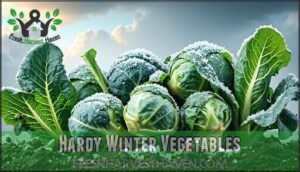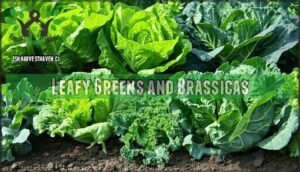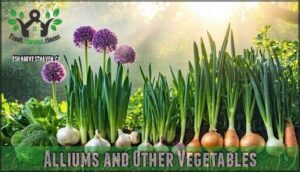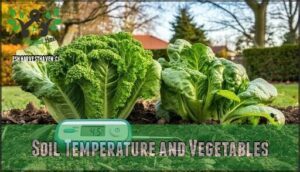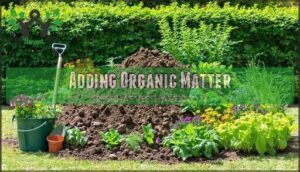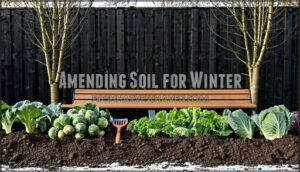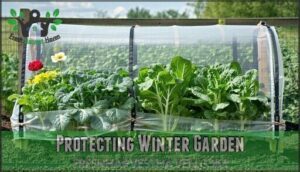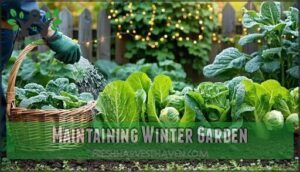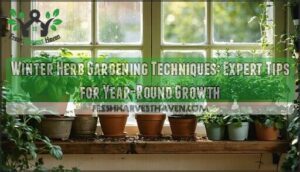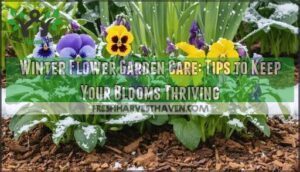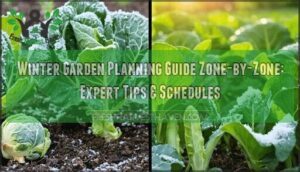This site is supported by our readers. We may earn a commission, at no cost to you, if you purchase through links.
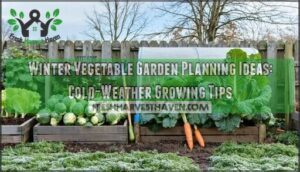 Winter vegetable garden planning ideas transform your cold-season landscape into a productive growing space.
Winter vegetable garden planning ideas transform your cold-season landscape into a productive growing space.
Start by evaluating your hardiness zone and selecting frost-tolerant varieties like kale, Brussels sprouts, and carrots. These cold-hardy champions actually sweeten after frost kisses their leaves.
Prepare raised beds with well-draining soil enriched with compost, ensuring proper drainage to prevent root rot. Create microclimates using cold frames, row covers, or hoop tunnels to extend your growing season.
Time your plantings strategically—cool-season crops need 10-12 weeks to mature before hard frost arrives. Don’t forget succession planting for continuous harvests throughout winter.
The secret lies in understanding soil temperature thresholds and frost protection techniques.
Table Of Contents
- Key Takeaways
- Winter Garden Planning
- Selecting Winter Vegetables
- Preparing Soil for Winter
- Protecting Winter Garden
- Maintaining Winter Garden
- Frequently Asked Questions (FAQs)
- How do you plan a Winter Garden?
- What can you plant in a winter vegetable garden?
- Can you grow vegetables in winter?
- Is gardening in winter a good idea?
- What is winter vegetable care?
- How to grow a garden in winter?
- What to plant in a winter vegetable garden?
- How to prepare vegetable garden beds for winter?
- Which vegetable is best to grow in winter?
- When should I start my winter garden?
- Conclusion
Key Takeaways
- Start with climate assessment – You’ll need to evaluate your hardiness zone and test your soil’s pH and drainage to select appropriate frost-tolerant varieties like kale, Brussels sprouts, and carrots.
- Time your plantings strategically – You should plant cool-season crops 10-12 weeks before your first expected hard frost to ensure proper establishment and maturity.
- Create protective structures – You can extend your growing season by using cold frames, row covers, or hoop tunnels that increase soil temperature by 5-10°F and provide essential frost protection.
- Focus on soil preparation and maintenance – You’ll achieve better results by adding 2-4 inches of compost, applying organic mulch for insulation, and monitoring soil temperature consistently throughout winter.
Winter Garden Planning
Planning your winter vegetable garden starts with understanding your local climate zone and soil conditions through proper testing and microclimate analysis.
You’ll need to select cold-hardy crops, prepare your garden beds with proper amendments, and design a layout that maximizes protection from harsh winter weather.
Assessing Climate and Soil
Understanding your specific climate zone and soil conditions forms the foundation of successful winter garden planning.
Check your USDA hardiness zone to determine which cold season crops will survive your winter temperatures and frost dates. Test your soil pH using a simple kit—most winter vegetables thrive between 6.0-7.0.
Dig a test hole after rain to assess drainage, since waterlogged soil kills root crops. Examine your property’s microclimates by noting sun exposure patterns and wind protection areas, as these factors substantially impact your winter gardening success.
Accurate soil analysis often requires a soil test to determine nutrient levels and pH balance.
Choosing Right Crops
Selecting winter hardy vegetables requires matching frost tolerance levels with your local climate conditions. Your crop selection strategy should prioritize varieties with proven climate resilience and soil adaptation capabilities for successful winter vegetable garden planning.
Consider these essential factors when choosing cold season crops:
- Hardiness ratings – Select coldhardy vegetables rated two zones below your area’s minimum temperature
- Harvest windows – Plan winter harvest crops with staggered maturity dates for continuous production
- Varietal resistance – Choose cultivars with natural disease resistance and winter gardening tips compatibility
Match your selections to microclimate conditions, soil drainage patterns, and available protection methods. This targeted approach guarantees your cold season crops will thrive despite challenging winter conditions.
Preparing Garden Bed
Your crops are chosen, now it’s time to prepare your garden beds for winter success.
Start with thorough soil testing to determine pH levels and nutrient content. Remove weeds completely and loosen compacted earth to improve drainage.
| Bed Preparation Step | Timing | Purpose |
|---|---|---|
| Soil Testing | Early fall | Assess pH and nutrients |
| Compost Addition | 4-6 weeks before planting | Enrich soil structure |
| Mulch Application | After planting | Insulate roots from cold |
Add 2-4 inches of quality compost to boost organic matter and create better soil structure.
Shape beds with gentle slopes for proper water runoff. Apply organic mulch around plants after establishment for insulation against temperature fluctuations.
Creating Garden Layout
Once you’ve prepared your garden bed, garden mapping becomes your blueprint for success. Spatial planning maximizes productivity by organizing plant grouping strategically—position tall brassicas to shield delicate lettuce from winter winds.
Design accessible path design between beds for easy harvesting, and create border creation with hardy perennials.
Winter garden layout considerations:
- Group cold-hardy vegetables by harvest timing
- Position tall plants on north side to prevent shading
- Create windbreaks using established shrubs or fencing
- Plan garden design with cold season gardening maintenance access in mind
Selecting Winter Vegetables
Selecting the right winter vegetables guarantees your garden produces fresh food throughout the cold months.
You’ll want to focus on hardy varieties that actually improve in flavor after exposure to frost, such as kale, carrots, and Brussels sprouts.
Hardy Winter Vegetables
Hardy winter vegetables form the foundation of your cold-season garden success. Kale survives temperatures down to 20°F (-6°C), while Brussels sprouts actually improve in flavor after frost exposure.
Winter’s chill transforms your garden into a frost-kissed powerhouse of flavor and nutrition.
These Cold Hardy Crops require minimal winter vegetable care yet deliver consistent Seasonal Harvesting opportunities.
| Vegetable | Temperature Tolerance | Harvest Period | Storage Life |
|---|---|---|---|
| Kale | 20°F (-6°C) | Nov-March | 1-2 weeks |
| Brussels Sprouts | 15°F (-9°C) | Oct-Feb | 3 months |
| Collard Greens | 15°F (-9°C) | Nov-April | 2-3 weeks |
| Spinach | 15°F (-9°C) | Oct-March | 1-2 weeks |
Frost Tolerant Plants like spinach and Swiss chard handle freezing conditions beautifully, making winter garden vegetables planning straightforward for Vegetable Storage success.
Root Crops for Winter
Winter garden success starts with selecting the right root crops for your climate.
Carrot Varieties like Nantes and Chantenay thrive in cold conditions, while Beet Growing becomes easier with Detroit Dark Red cultivars.
Radish Care requires quick-maturing types like Cherry Belle for continuous harvests.
Turnip Harvesting peaks after frost sweetens their flavor.
These frost tolerant plants form the backbone of winter vegetable garden planning, providing reliable nutrition when other crops fail.
For effective growth, understanding seed quality factorscarrot seed is vital for a successful harvest.
Leafy Greens and Brassicas
Transform your winter garden into a nutritional powerhouse with leafy greens and brassicas that thrive in freezing temperatures.
Kale varieties like ‘Winterbor’ demonstrate exceptional cool season gardening resilience, while spinach care becomes effortless as cold weather intensifies its flavor.
Lettuce types such as ‘Winter Density’ and arugula benefits include improved taste after frost exposure, making your winter vegetable garden planning both practical and rewarding for sustained harvests.
Alliums and Other Vegetables
Your winter vegetable garden planning benefits enormously from allium varieties that deliver exceptional flavor powerhouse results.
Garlic care becomes straightforward when you plant cloves in fall, while onion varieties like scallions thrive throughout autumn months.
Leek recipes showcase these cold-hardy champions that improve after frost exposure.
Root harvesting techniques facilitate proper timing, while vegetable storage methods preserve your harvest for months.
These cool season gardening stars provide natural pest control benefits through companion planting.
Your winter gardening guide should prioritize these winter vegetable seeds for reliable cold season gardening success and continuous fresh ingredients.
Effective soil preparation techniques are vital for a thriving winter garden.
Preparing Soil for Winter
Your soil’s temperature and structure determine which vegetables will thrive through winter’s harsh conditions.
You’ll need to add organic matter and amend your soil properly before the growing season begins to guarantee superior root development and nutrient availability.
Soil Temperature and Vegetables
Understanding soil temperature drives successful winter vegetable garden planning.
Your cold hardy crops need 40-50°F soil for proper germination and root development.
Use Soil Testing methods to measure temperatures at 2-4 inches deep with a digital thermometer.
Temperature Control through mulch effects and black plastic sheeting maintains consistent winter garden soil warmth.
Soil Monitoring helps you select appropriate root vegetables and plan Frost Protection strategies.
Remember, consistent soil warmth matters more than air temperature for Vegetable Selection success.
Adding Organic Matter
Success in winter soil preparation depends on enriching your garden beds with nutrient-rich organic matter. You’ll create healthier growing conditions by incorporating aged compost and manure fertilizer into your soil structure. Compost tea provides additional liquid nutrition for established plants.
Here are four essential soil amendments for winter preparation:
- Layer aged compost 2-3 inches deep across garden beds
- Mix cow or chicken manure into planting areas
- Apply leaf mold for improved soil structure
- Add kitchen scraps to existing compost piles
These organic fertilizers work together to create ideal soil preparation conditions for winter vegetables.
Amending Soil for Winter
Building healthy soil foundation requires strategic amendments that support winter vegetable growth.
After adding organic matter, fine-tune your soil’s chemical balance through targeted modifications.
Follow these essential soil preparation steps:
- Conduct soil testing – Check pH levels and nutrient content using digital meters or laboratory analysis
- Apply organic matter – Mix aged compost and compost tea into beds for sustained nutrient release
- Layer protective mulch – Add 2-4 inches of organic mulch layers around plants for insulation
These soil amendments create ideal growing conditions for cold-hardy vegetables throughout winter months.
Understanding soil preparation basics is vital for a successful winter garden.
Protecting Winter Garden
You’ll need protective barriers to shield your winter vegetables from harsh weather conditions that can damage or kill tender plants.
Row covers, cold frames, and mulching techniques create microclimates that maintain soil temperature and protect crops from frost damage.
Using Mulch for Insulation
How does proper mulching transform your winter vegetable garden into a thriving cold-weather oasis? Mulch Benefits extend far beyond basic Soil Insulation—creating essential Winter Protection for your crops.
Apply straw three to four inches deep around plants for ideal Frost Prevention and Garden Bedding stability.
This winter garden planning technique maintains consistent soil temperatures while suppressing weeds.
Mulch serves as nature’s blanket, making cold climate gardening more successful.
Your winter vegetable garden gains resilience through strategic frost protection applications that safeguard root systems during harsh conditions.
Creating Cold Frame or Hoop
Beyond mulch insulation, cold frames and hoop houses offer your winter vegetable garden superior frost protection through controlled microclimates. These structures can boost soil temperatures by 5-10°F, extending your growing season by 6-8 weeks even in harsh conditions.
Frame materials like recycled windows or polycarbonate panels create effective DIY construction options. Hoop design using PVC or metal conduit supports polyethylene covers that provide 80-90% light transmission while maintaining temperature regulation. For those seeking convenience, consider purchasing a pre-made option.
Consider these essential elements for success:
- Ventilation needs: Install automatic vent openers or prop lids open on warm days to prevent overheating
- Cold frame positioning: Face south with wind protection for ideal solar gain and easy access
- Hoop house spacing: Allow 2-3 feet between hoops for structural stability and plastic tension
Your cold-weather crops will thrive under these protective structures, with leafy greens showing 30-50% higher yields compared to open ground cultivation.
Protecting Plants From Frost
Cold frames provide controlled environments, but frost protection requires additional strategies when temperatures plummet below your vegetables’ tolerance levels.
You’ll need multiple frost protection methods to safeguard your crops effectively.
| Protection Method | Temperature Range | Best Crops |
|---|---|---|
| Frost cloth | 28-32°F | Leafy greens, herbs |
| Row covers | 25-30°F | Brassicas, root vegetables |
| Mulch layers | 20-28°F | Garlic, overwintering onions |
Frost Blanket Types include lightweight fabrics that allow air circulation while trapping heat.
Microclimate Selection around your garden helps identify naturally warmer spots.
Snow Cover Benefits act as natural insulation when temperatures drop.
Harden Off Seedlings gradually by reducing protection during warm spells.
Avoid Watering During Frost periods, as wet soil freezes faster than dry soil.
Using Row Covers for Protection
Row covers provide exceptional frost protection for your winter vegetable garden.
These lightweight, breathable fabrics create a protective microclimate that shields cold season vegetables from harsh weather while maintaining proper light transmission.
- Temperature regulation – Row Cover Material increases soil temperature by 4-6°F
- Natural pest control – Blocks insects without chemical interventions
- Simple installation techniques – Drape over hoops or secure with garden staples
- Optimal light transmission – Allows 85% sunlight penetration for photosynthesis
- Extended harvest period – Keeps frost resistant vegetables producing longer
Effective frost protection methods are essential for a successful winter garden.
Maintaining Winter Garden
Once you’ve established your winter garden, maintaining it requires consistent monitoring and care to guarantee healthy growth throughout the cold season.
You’ll need to adjust your watering schedule, apply appropriate fertilizers, track soil temperatures, and watch for winter-specific pests and diseases that can threaten your crops, which is crucial for healthy growth.
Watering Winter Vegetables
Winter vegetables require careful water management to thrive in cold conditions.
Check soil moisture regularly since dormant plants need less water than summer crops. Water deeply but infrequently to prevent root rot.
Morning winter irrigation works best, allowing excess moisture to evaporate before nighttime freezing.
Consider drip systems for efficient water delivery and rainwater harvesting for sustainable winter garden care.
Fertilizing Winter Vegetables
Proper nutrition keeps your winter vegetables strong against harsh conditions.
You’ll want to focus on potassium-rich organic fertilizers that strengthen cell walls and improve cold tolerance, while avoiding high-nitrogen products that create frost-vulnerable growth.
Smart fertilizing approaches for winter success:
- Apply compost tea monthly during active growth periods to deliver gentle, steady nutrition
- Work winter manure into beds before planting to slowly release nutrients throughout the season
- Choose balanced organic fertilizers that provide natural nutrients without forcing excessive leaf production
Soil amendments like aged compost and organic matter create the foundation for healthy winter crops.
Time your applications before heavy rains wash nutrients away, and remember that root vegetables need different nutrition than leafy greens.
Understanding natural fertilizer benefits is essential for maintaining a thriving winter garden.
Monitoring Soil Temperature
Your winter vegetable garden success depends on accurate soil temperature monitoring using reliable soil probes and temperature gauges.
Digital soil sensors provide precise thermometer readings at 2-4 inch depths, essential for soil preparation and cold hardy crops success.
Frost alerts help you protect plants when temperatures drop below critical thresholds.
Managing Pests and Diseases
Beyond monitoring soil temperature, effective pest control becomes your next priority for winter garden success.
Winter garden pests like aphids, slugs, and fungal diseases thrive in cool, moist conditions despite lower temperatures.
Organic methods such as neem oil applications and companion planting provide excellent biological control without harsh chemicals.
Crop rotation prevents soil-borne pathogens from establishing permanent residence in your beds.
Implement winter IPM strategies by removing infected plant debris weekly and maintaining proper air circulation.
Disease prevention starts with clean tools and balanced watering schedules.
Garden pest control requires vigilance—inspect plants regularly for early intervention success.
Frequently Asked Questions (FAQs)
How do you plan a Winter Garden?
Start by evaluating your hardiness zone and microclimates to select appropriate cold-tolerant plants.
Test soil pH, plan structural elements like raised beds, and choose hardy vegetables such as kale, carrots, and garlic for ideal winter success.
What can you plant in a winter vegetable garden?
You’ll find success with cold-hardy crops like kale, carrots, and spinach that actually taste sweeter after frost. Plant root vegetables, leafy greens, and brassicas for reliable winter harvests.
Can you grow vegetables in winter?
Like a determined gardener weathering nature’s harshest season, you’ll absolutely thrive growing cold-hardy vegetables through winter months.
Root vegetables, leafy greens, and brassicas tolerate frost beautifully, often developing sweeter flavors when properly protected.
Is gardening in winter a good idea?
Winter gardening offers excellent opportunities if you’re strategic about it.
You’ll extend your growing season, enjoy fresh produce year-round, and tackle important garden preparation tasks.
Cold-hardy vegetables like kale, carrots, and spinach actually taste sweeter after frost exposure.
What is winter vegetable care?
Caring for winter vegetables requires consistent moisture monitoring, protective mulching, and strategic harvesting.
You’ll need to shield crops from harsh winds, maintain proper soil drainage, and harvest regularly to encourage continued growth throughout colder months, which involves consistent moisture monitoring.
How to grow a garden in winter?
Choose cold-hardy vegetables like kale, carrots, and spinach that thrive in freezing temperatures.
Use row covers, cold frames, or mini hoop tunnels for protection.
Plant in well-draining soil with adequate mulching.
What to plant in a winter vegetable garden?
Plant carrots, kale, spinach, and garlic—these frost-kissed champions thrive in cold weather. Root vegetables like beets and radishes sweeten after frost, while leafy greens flourish in winter’s embrace.
How to prepare vegetable garden beds for winter?
First, test your soil’s pH and drainage by digging a test hole after rainfall.
Add 2-4 inches of compost or aged manure, then apply mulch around plants, avoiding stems to prevent rot and pest issues.
Which vegetable is best to grow in winter?
Kale stands out as winter’s champion vegetable, thriving in freezing temperatures while becoming sweeter after frost exposure.
You’ll find varieties like Winterbor kale particularly hardy, surviving temperatures down to 10°F when properly established.
When should I start my winter garden?
Timing’s everything in winter gardening—start your cold-season crops 10-12 weeks before your first expected frost date for ideal germination and establishment before harsh weather arrives.
Conclusion
Ready to transform your outdoor space into a winter wonderland of fresh produce?
Successfully implementing winter vegetable garden planning ideas requires careful attention to timing, soil preparation, and plant protection strategies.
Your cold-season garden will thrive when you select appropriate cultivars, monitor soil temperatures consistently, and provide adequate frost protection through row covers or cold frames.
Remember that proper drainage prevents root rot while organic matter amendments enhance soil structure, allowing you to enjoy continuous harvests of nutrient-dense vegetables throughout the coldest months, with the right techniques, you’ll have a thriving garden that provides nutrient-dense vegetables.

